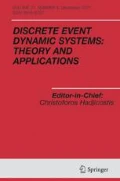Abstract
This paper presents epistemic characterizations to co-observability conditions in decentralized supervisory control of discrete-event systems. The logical characterizations provide more intuitive interpretations of the various co-observability conditions, and make immediately apparent the relations between the conditions. Closures under set union of some of the conditions are also discussed.





Similar content being viewed by others
Notes
The term “states” should cause no confusion in this context, since the worlds in the frames we construct in this work happen to be states of some FSA.
Readers familiar with modal logics should note that by stating “have S” we do not mean that S is valid, i.e., S evaluates to true at every interpretation and every world, since that concept has not been defined here.
For detailed discussion on the control decisions weak off and weak on, see the works by Yoo and Lafortune (2004) and Ricker and Rudie (2007) and Ritsuka and Rudie (2022) and Ritsuka and Rudie (2021). Note that Yoo and Lafortune (2004) and Ricker and Rudie (2007) use different names for the control decisions.
This result gives us an inspiration: given two languages L(E1) and L(E2) synthesisable in the architecture A, we should not confine ourselves in synthesizing the union language L(E) in the architecture A, but instead be willing to look for an alternative architecture B in which we can synthesize L(E). Then let all architectures ordered by their strength, we’d then like to ask: does there exist a supremal architecture?
References
Cassandras CG, Lafortune S (2007) Introduction to Discrete Event Systems, 2nd edn. Springer-Verlag GmbH
Cieslak R, Desclaux C, Fawaz AS, Varaiya P (1988) Supervisory control of discrete-event processes with partial observations. IEEE Trans Autom Control 33(3):249–260. https://doi.org/10.1109/9.402
Fagin R, Halpern JY, Moses Y, Vardi M (2004) Reasoning About Knowledge. The MIT Press. https://doi.org/10.7551/mitpress/5803.001.0001
Halpern JY, Moses Y (1990) Knowledge and common knowledge in a distributed environment. J ACM 37(3):549–587. https://doi.org/10.1145/79147.79161
Kumar R, Takai S (2005) Inference-based ambiguity management in decentralized decision-making: Decentralized control of discrete event systems. In: Proceedings of the 44th IEEE Conference on Decision and Control, IEEE. https://doi.org/10.1109/CDC.2005.1582701
Lin F, Wonham WM (1988) On observability of discrete-event systems. Inf Sci 44(3):173–198. https://doi.org/10.1016/0020-0255(88)90001-1
Prosser JH, Kam M, Kwatny HG (1997) Decision fusion and supervisor synthesis in decentralized discrete-event systems. In: Proceedings of the American Control Conference, IEEE. https://doi.org/10.1109/ACC.1997.608978
Ramadge PJ, Wonham WM (1987) Supervisory control of a class of discrete event processes. SIAM J Control Optim 25(1):206–230. https://doi.org/10.1137/0325013
Ricker SL, Rudie K (2000) Know means no: Incorporating knowledge into discrete-event control systems. IEEE Trans Autom Control 45(9):1656–1668. https://doi.org/10.1109/9.880616
Ricker SL, Rudie K (2007) Knowledge is a terrible thing to waste: Using inference in discrete-event control problems. IEEE Trans Autom Control 52(3):428–441. https://doi.org/10.1109/TAC.2007.892371
Ritsuka K, Rudie K (2021) A visualization of inference-based supervisory control in discreteevent system. In: Proceedings of the 60th IEEE Conference on Decision and Control (CDC), 2021, IEEE, pp. 1062–1068, https://doi.org/10.1109/CDC45484.2021.9683210
Ritsuka K, Rudie K (2022) Do what you know: Coupling knowledge with action in discrete-event systems, submitted for publication.
Rudie K, Wonham WM (1990) The infimal prefix-closed and observable superlanguange of a given language. Systems & Control Letters 15(5):361–371. https://doi.org/10.1016/0167-6911(90)90059-4
Rudie K, Wonham WM (1992) Think globally, act locally: Decentralized supervisory control. IEEE Trans Autom Control 37 (11):1692–1708. https://doi.org/10.1109/9.173140
Takai S, Ushio T (2001) Strong co-observability conditions for decentralized supervisory control of discrete event systems. In: Proceedings of the 40th IEEE Conference on Decision and Control (CDC), 2001, IEEE, pp. 4098–4103 vol.5, https://doi.org/10.1109/CDC.2001.980821
Takai S, Ushio T (2002) A modified normality condition for decentralized supervisory control of discrete event systems. Automatica 38(1):185–189. https://doi.org/10.1016/s0005-1098(01)00187-x
Takai S, Kumar R, Ushio T (2005) Characterization of co-observable languages and formulas for their super/sublanguages. IEEE Trans Autom Control 50 (4):434–447. https://doi.org/10.1109/tac.2005.844724
Wonham WM, Cai K (2018) Supervisory Control of Discrete-Event Systems. Springer-Verlag GmbH
Yoo TS, Lafortune S (2002) A general architecture for decentralized supervisory control of discrete-event systems. Discrete Event Dynamic Systems 12 (3):335–377. https://doi.org/10.1023/a:1015625600613
Yoo TS, Lafortune S (2004) Decentralized supervisory control with conditional decisions: Supervisor existence. IEEE Trans Autom Control 49(11):1886–1904. https://doi.org/10.1109/tac.2004.837595
Acknowledgements
The research described in this paper was undertaken at Queen’s University, which is situated on traditional Anishinaabe and Haudenosaunee territory. The research was inspired by and supported through an NSERC CRD-DND project with General Dynamics Land Systems-Canada and Defence Research and Development Canada.
Author information
Authors and Affiliations
Corresponding author
Ethics declarations
Conflict of Interests
The authors declare that they have no conflict of interest.
Additional information
Publisher’s note
Springer Nature remains neutral with regard to jurisdictional claims in published maps and institutional affiliations.
This work was financially supported by the Natural Sciences and Engineering Research Council of Canada (NSERC) through a Collaborative Research and Development Grant together with General Dynamics Land Systems (K.Ritsuka) and an NSERC Discovery Grant (K.Rudie).
Rights and permissions
Springer Nature or its licensor (e.g. a society or other partner) holds exclusive rights to this article under a publishing agreement with the author(s) or other rightsholder(s); author self-archiving of the accepted manuscript version of this article is solely governed by the terms of such publishing agreement and applicable law.
About this article
Cite this article
Ritsuka, K., Rudie, K. Epistemic interpretations of decentralized discrete-event system problems. Discrete Event Dyn Syst 32, 359–398 (2022). https://doi.org/10.1007/s10626-022-00363-7
Received:
Accepted:
Published:
Issue Date:
DOI: https://doi.org/10.1007/s10626-022-00363-7




